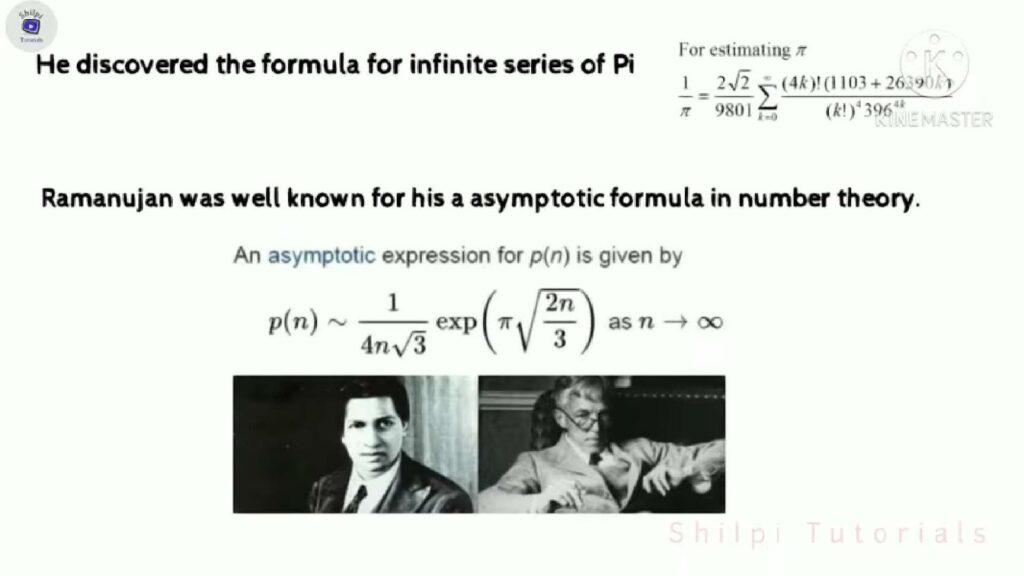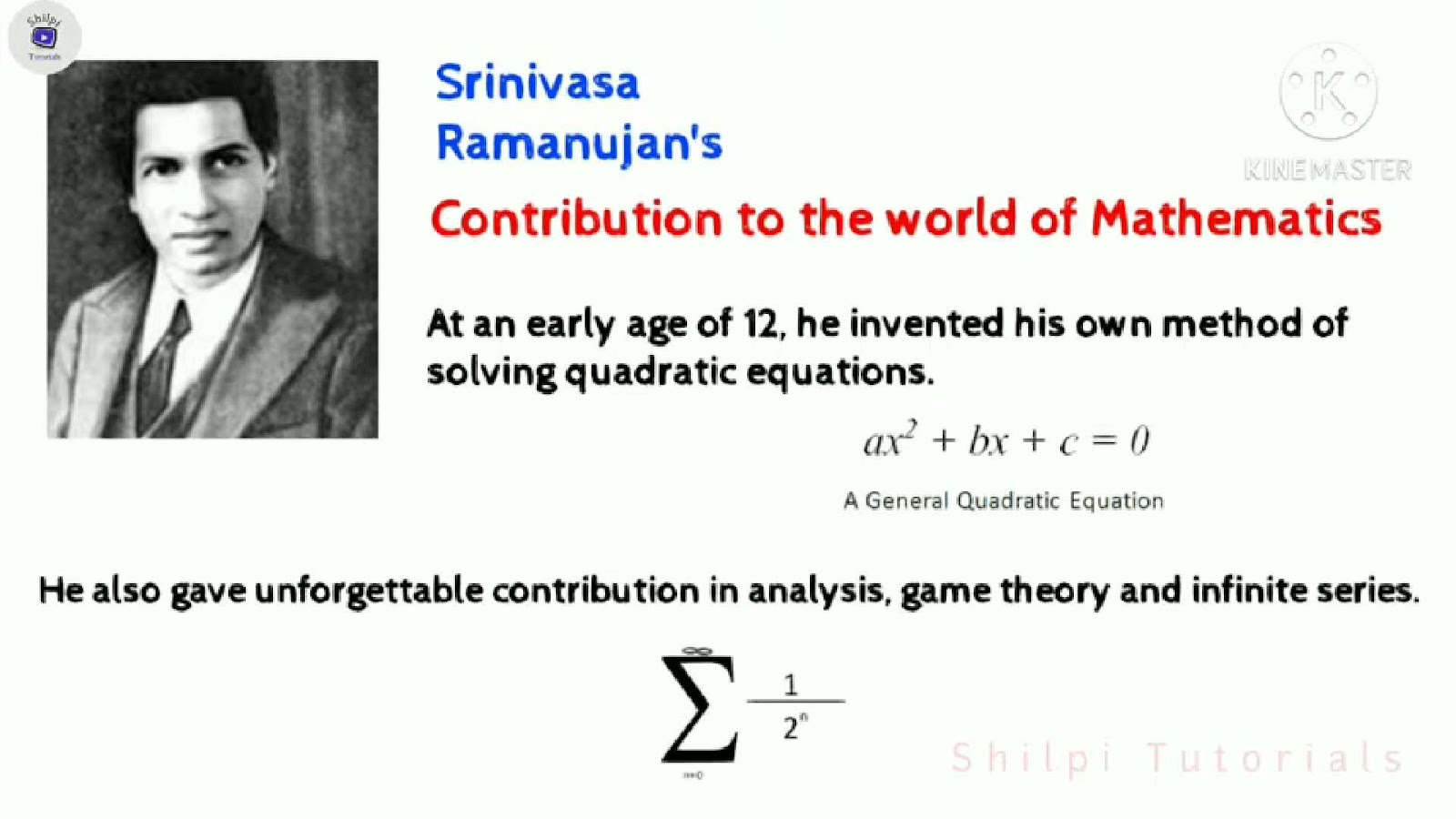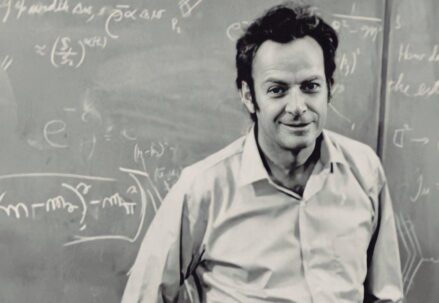In the annals of mathematical history, a name continues to reverberate with profound respect and veneration. Srinivasa Ramanujan, an illustrious Indian mathematician, emerged as a prodigious genius during his formative years. Astonishingly, despite a dearth of access to advanced mathematical resources, he exhibited his extraordinary intellectual prowess from a tender age. His life narrative, marked by humble and occasionally challenging beginnings, unfolds as a captivating tale in its own right, parallel to his astounding mathematical contributions.
Born on December 22, 1887, in Erode, situated in the heart of Tamil Nadu, India, Srinivasa Ramanujan entered this world. His father, K. Srinivasa Iyengar, toiled as an accounting clerk for a textile merchant, while his mother, Komalatammal, eked out a modest income as a local temple vocalist. Hailing from a devout Hindu Brahmin lineage, his mother diligently nurtured his immersion in Brahmin traditions and cultural heritage. It is worth noting that, despite their high-caste background, Ramanujan’s family grappled with impoverishment.
EARLY MATHEMATICS: Nurturing Genius through Obsession
Imagine a young boy, just 15 years old, immersing himself in the world of numbers, tirelessly scribbling equations on a slate, and losing himself in the labyrinthine realms of mathematical wonders, both day and night. Such was the life of Srinivasa Ramanujan, an Indian prodigy whose passion for mathematics knew no bounds. However, what fueled his obsession was not a renowned textbook brimming with the latest mathematical marvels but a rather unassuming tome: “A Synopsis of Elementary Results in Pure and Applied Mathematics” by George Shoobridge Carr, first published in 1880 and later revised in 1886.
Key Insights:
- Ramanujan’s fascination with mathematics was all-consuming, as he dedicated his every waking moment to exploring the intricate world of numbers;
- Carr’s book, although not authored by a famous mathematician and devoid of elaborate proofs, became Ramanujan’s gateway to the mathematical universe;
- This book comprised thousands of theorems, many without proofs, and those with proofs were presented tersely.
Ramanujan’s Encounter:
In the year 1903, at the tender age of 15, Ramanujan stumbled upon Carr’s book. What set this book apart from others was its lack of a systematic structure, presenting theorems in a rather haphazard fashion. Remarkably, this unconventional approach encouraged Ramanujan to dive headfirst into mathematical exploration and forge his own connections within the subject.
Self-Education and Devotion:
Ramanujan’s initial exposure to Carr’s book was not just a casual encounter; it was the beginning of an extraordinary journey. Even though the book’s proofs were often mere one-liners, they gave Ramanujan the false impression that mathematics required little rigor. Ramanujan transformed Carr’s book into his constant companion, refining and expanding upon its contents as he self-educated himself in the world of mathematics.
By exploring uncharted territory and daring to make connections that others had not, Ramanujan laid the foundation for his future groundbreaking contributions to the field.
EARLY FAILURES: Triumph through Resilience
The life of Srinivasa Ramanujan, often romanticized as a mathematical genius, was not without its share of setbacks and failures, particularly during his early years. While his mathematical acumen was undeniable, his obsession with numbers came at a cost.
Challenges at the Outset:
Despite his remarkable mathematical talents, Ramanujan faced a series of disappointments in his academic pursuits. His relentless focus on mathematics prevented him from passing his intermediate examination, an essential milestone in his education. In fact, he struggled to even attain the minimum passing marks in subjects outside of mathematics.
Scholarship Loss:
In 1904, Ramanujan earned a college scholarship, a promising opportunity that seemed to cement his path to a bright future. However, his inability to excel in non-mathematical subjects led to the swift loss of this scholarship.
Madras College: A False Start:
His journey continued as he attempted college in Madras (now Chennai), but again, he faced adversity. He failed his first Arts exam, which could have potentially spelled the end of his academic aspirations.
Inception of the Notebooks:
It was during these trying times that Ramanujan began what would later become famous as his “notebooks.” These notebooks were not just records of mathematical equations; they were windows into the mind of a mathematical savant. Filled with theorems, conjectures, and formulas, these notebooks would go on to contain some of the most profound mathematical discoveries of the 20th century.
Resilience and Perseverance:
Ramanujan’s early failures did not deter him. Instead, they fueled his determination to continue exploring the mathematical landscapes of his mind. These setbacks became the stepping stones to his eventual success, as he went on to make groundbreaking contributions to number theory, modular forms, and other areas of mathematics.
Key Takeaways:
- Ramanujan’s early failures were a testament to the challenges he faced beyond mathematics;
- His notebooks, begun during this period, would ultimately change the course of mathematics;
- Ramanujan’s story teaches us the importance of resilience, determination, and unwavering passion in the face of adversity.
Unlocking Ramanujan’s Journey to Mathematical Greatness
In the year 1907, a young and impoverished Srinivasa Ramanujan began to ponder his destiny in the realm of mathematics. With no formal college education to his name and a desperate need for a patron, his mathematical aspirations hung in the balance. It was during this pivotal moment that Seshu Aiyar, a professor at Presidency College in Madras, came to his aid with a remarkable suggestion: write letters to G.H. Hardy, a venerable figure in the mathematical world.
- Ramanujan’s humble beginnings: Born into a modest family in Erode, India, Ramanujan’s mathematical prowess was evident even from a young age. However, his lack of formal education limited his opportunities in the field;
- The turning point: Professor Seshu Aiyar’s sage advice to reach out to G.H. Hardy, a renowned mathematician, marked the beginning of Ramanujan’s extraordinary journey into the world of mathematics.
The Enigmatic Mathematical Notes
Upon receiving Ramanujan’s correspondence, Professor Hardy embarked on an intellectual adventure like no other. Enclosed within were nine pages of mathematical notes that defied conventional understanding; they appeared almost otherworldly.
- The puzzle: Hardy shared Ramanujan’s notes with J. E. Littlewood, another eminent Cambridge mathematician. Together, they embarked on a perplexing journey, attempting to decipher the enigmatic work before them;
- Crank or genius: Hardy was left perplexed, admitting that the notes could have been authored by either a mathematical eccentric or a true genius. Littlewood joined him in this quest to unravel the mystery;
- A genius revealed: After investing two and a half hours in intense scrutiny, the mathematicians reached a stunning conclusion – they were gazing at the work of a mathematical genius, unparalleled in their time.
The Cambridge Connection: A Mathematical Renaissance
Hardy’s fascination with Ramanujan’s letters and notes transcended personal curiosity; he decided to share this mathematical treasure with his colleagues at the University of Cambridge. This decision marked the dawn of a new era in mathematics, showcasing the profound beauty of the subject and illustrating the power of friendship in overcoming barriers of ethics, culture, and religion.
- The camaraderie of mathematics: Ramanujan’s arrival at Cambridge in April 1914, just months before the outbreak of World War I, brought together a trio of remarkable minds – Ramanujan, Hardy, and Littlewood – all driven by their shared passion for mathematics;
- Recognizing Ramanujan’s brilliance: In a mere matter of days, Ramanujan commenced his collaboration with Hardy and Littlewood, setting in motion a journey of mathematical exploration. Remarkably, within two years, he was honored with the equivalent of a Ph.D. for his exceptional contributions.
Unveiling Ramanujan’s Mathematical Legacy
Ramanujan’s time in Cambridge was marked by a prolific outpouring of mathematical brilliance, leaving Hardy and Littlewood astounded by the sheer magnitude of his contributions. His notebooks, brought from India, were veritable treasure troves, filled with thousands of mathematical identities, equations, and theorems, many of which were entirely novel.
- A mathematical marvel: Ramanujan’s insights into algebraic formulae and transformations of infinite series were unparalleled. Hardy, who had encountered some of the greatest mathematical minds in history, likened Ramanujan’s genius to that of Euler or Jacobi;
- A legacy of discovery: The notebooks he brought from India covered the years 1903 to 1914 and contained a wealth of mathematical discoveries. Some of these discoveries had been made by earlier mathematicians, some were inaccurately attributed, and many were entirely new, showcasing Ramanujan’s unparalleled intuition and creativity.
Ramanujan’s Remarkable Mathematical Genius and Divine Inspiration
Srinivasa Ramanujan, an extraordinary mathematical prodigy, possessed a gift that transcended conventional boundaries. His mathematical prowess was unparalleled, despite his limited formal training in the field. Incredibly, Ramanujan’s incredible insights often emerged from what he believed to be divine intervention.
- Divine Revelation: Ramanujan’s belief in a higher power was a driving force behind his work. He recounted a vivid dream where the Hindu Goddess Namagiri appeared, inscribing elliptic integrals on a screen of flowing blood. This supernatural experience left an indelible mark on him, inspiring his groundbreaking mathematical discoveries;
- The Birth of Equations: The elliptic integrals that Ramanujan saw in his dream were not forgotten upon awakening; instead, they became the foundation of his work. He meticulously transcribed these revelations, leading to a multitude of theorems, formulas, and conjectures that continue to influence the field of mathematics to this day;
- Bruce Berndt’s Dedication: Professor Bruce Berndt, an analytic number theorist, has dedicated decades to unraveling the mysteries of Ramanujan’s theorems. His relentless pursuit of understanding Ramanujan’s work has resulted in several illuminating books and deep insights into the genius of this mathematical savant;
- Hardy’s Assessment: Paul Erdos, a renowned Hungarian mathematician, shared a captivating anecdote about the assessment of mathematical talent. G. H. Hardy, a prominent mathematician, rated himself a modest 25 on a talent scale, while luminaries like Hilbert scored 80. Astonishingly, Ramanujan was bestowed with a perfect 100, underscoring his exceptional abilities that transcended conventional grading.
Ramanujan’s Impact on Number Theory and String Theory
Ramanujan’s legacy extends beyond mathematics, reaching into the realm of theoretical physics. His unparalleled insights have made a profound impact on number theory and string theory, reshaping our understanding of the universe.
- Royal Society Fellowship: In 1918, Ramanujan made history by becoming the first Indian mathematician to be elected as a Fellow of the British Royal Society. This honor recognized his exceptional contributions to the world of mathematics;
- Prolific Output: Despite his tragically short life, Ramanujan’s mathematical output was nothing short of astonishing. He left behind a legacy of almost 4000 proofs, identities, conjectures, and equations. These contributions continue to serve as a wellspring of inspiration for mathematicians and physicists alike;
- The Theta Function: At the core of Ramanujan’s mathematical revelations lies the Theta function, a powerful mathematical concept. Surprisingly, this function found its way into the heart of string theory in physics. Each of the 24 modes within the Ramanujan function corresponds to a distinct physical vibration of a string;
- String Theory Unveiled: As Michio Kaku, a prominent physicist, aptly put it, Ramanujan’s mathematical identities play a pivotal role in string theory. These complex motions of strings in space-time, involving splitting and recombination, must satisfy highly sophisticated mathematical identities discovered by Ramanujan. This intersection of mathematics and physics reveals the deep connection between Ramanujan’s genius and the fundamental nature of the universe.
Discovering the Infinite: Ramanujan’s Extraordinary Pi Series
In the realm of mathematics, the enigmatic Indian mathematician Srinivasa Ramanujan is celebrated for his brilliant insights and remarkable contributions. In one of his astonishing notebooks, Ramanujan unveiled an astounding revelation: 17 distinct methods to represent the reciprocal of pi (1/pi) as an infinite series. While series representations for pi have been known for centuries, Ramanujan’s discoveries were nothing short of groundbreaking. Let’s delve deeper into Ramanujan’s remarkable mathematical journey and his incredible series that accelerated the quest for precision in approximating pi.
Historical Perspective on Pi Series:
- Pi, the ratio of a circle’s circumference to its diameter, has captivated mathematicians throughout history;
- The Gregory-Leibniz series, dating back to the 17th century, is a classic example: pi/4 = 1 – 1/3 + 1/5 – 1/7 + …;
- However, this series converges at an agonizingly slow pace, requiring over 600 terms to reach 3.14 accurately.
Ramanujan’s Ingenious Series:
- Ramanujan’s formula for 1/pi is a masterpiece of mathematical elegance: 1/pi = (sqrt(8)/9801) * (1103 + 659832/24591257856 + …);
- Astonishingly, this series swiftly approximates pi; it reaches 3.141592 after the first term and adds eight correct decimal places with each subsequent term;
- This series even played a pivotal role in 1985 when it was employed to calculate pi to over 17 million digits, though it remains unproven to this day.
Legacy and Significance:
- Ramanujan’s contributions continue to inspire mathematicians, showcasing the beauty and power of mathematical exploration;
- His series revolutionized the pursuit of pi, making it accessible with unprecedented speed and precision;
- The quest to understand the underlying principles behind Ramanujan’s series remains a compelling challenge for contemporary mathematicians.
Unveiling Taxicab Numbers: Hardy and Ramanujan’s Encounter
In the annals of mathematical history, the tale of G. H. Hardy’s taxi ride to visit Ramanujan is an iconic moment. During this encounter, Ramanujan introduced Hardy to the intriguing concept of taxicab numbers, which has since become a celebrated mathematical puzzle.

The Hardy-Ramanujan Number:
- Hardy arrived at Ramanujan’s location in a cab with the rather mundane number 1729;
- Commenting on the dullness of the number, Hardy was met with Ramanujan’s swift and profound insight;
- Ramanujan revealed that 1729 is no ordinary number; it’s the smallest number expressible as the sum of two cubes in two distinct ways: 1^3 + 12^3 and 9^3 + 10^3;
- This number is now known as the Hardy-Ramanujan number, immortalizing their remarkable collaboration.
Taxicab Numbers and Mathematical Curiosity:
- Taxicab numbers refer to integers that can be expressed as the sum of two cubes in multiple unique ways;
- The quest to find these numbers has intrigued mathematicians, leading to the discovery of subsequent taxicab numbers;
- For example, the smallest number expressible as the sum of two cubes in three distinct ways is 87,539,319.
The Profound Bond Between Hardy and Ramanujan:
Beyond their mathematical collaborations, Hardy served as a fatherly figure to Ramanujan.
Hardy’s high expectations and mentorship played a crucial role in nurturing Ramanujan’s genius.
In a heartfelt tribute, Hardy once remarked, “For my part, it is difficult for me to say what I owe to Ramanujan.”
Conclusion
In conclusion, Srinivasa Ramanujan’s remarkable journey from impoverished beginnings to becoming a mathematical genius stands as a testament to the power of innate talent and unyielding dedication. His enduring legacy in the world of mathematics, with over 3,900 theorems and results to his name, continues to inspire and command respect. Ramanujan’s story serves as a reminder that brilliance can emerge from the most unlikely of circumstances, transcending barriers and leaving an indelible mark on the annals of history.





